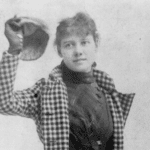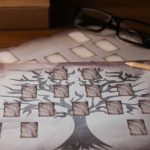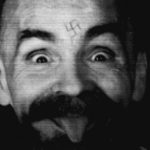 Humans
Humans  Humans
Humans  Animals
Animals 10 Animals That Humiliated and Harmed Historical Leaders
 History
History 10 Most Influential Protests in Modern History
 Creepy
Creepy 10 More Representations of Death from Myth, Legend, and Folktale
 Technology
Technology 10 Scientific Breakthroughs of 2025 That’ll Change Everything
 Our World
Our World 10 Ways Icelandic Culture Makes Other Countries Look Boring
 Misconceptions
Misconceptions 10 Common Misconceptions About the Victorian Era
 Mysteries
Mysteries 10 Strange Unexplained Mysteries of 2025
 Miscellaneous
Miscellaneous 10 of History’s Most Bell-Ringing Finishing Moves
 History
History 10 Great Escapes That Ended Right Back in Captivity
 Humans
Humans 10 Everyday Human Behaviors That Are Actually Survival Instincts
 Animals
Animals 10 Animals That Humiliated and Harmed Historical Leaders
 History
History 10 Most Influential Protests in Modern History
Who's Behind Listverse?

Jamie Frater
Head Editor
Jamie founded Listverse due to an insatiable desire to share fascinating, obscure, and bizarre facts. He has been a guest speaker on numerous national radio and television stations and is a five time published author.
More About Us Creepy
Creepy 10 More Representations of Death from Myth, Legend, and Folktale
 Technology
Technology 10 Scientific Breakthroughs of 2025 That’ll Change Everything
 Our World
Our World 10 Ways Icelandic Culture Makes Other Countries Look Boring
 Misconceptions
Misconceptions 10 Common Misconceptions About the Victorian Era
 Mysteries
Mysteries 10 Strange Unexplained Mysteries of 2025
 Miscellaneous
Miscellaneous 10 of History’s Most Bell-Ringing Finishing Moves
 History
History 10 Great Escapes That Ended Right Back in Captivity
10 Historical Figures You Didn’t Know Had Tattoos
Yes, Grandma, I know they’re there forever.
It’s incredible how far tattoos have come in the past few decades. Though some still see them as unprofessional or crude, for the most part, tattoos have become part of popular culture. The most famous movie and pop stars all sport some colorful ink, and you can find a tattoo shop in pretty much any city.
But it didn’t always used to be like that. For years, tattoos were associated with sailors and the lower classes, which makes it all the more surprising to find out that many royals and celebrities back in the day also had tattoos. Here are some historical figures you might not know had tattoos.
Related: 10 Historical Figures with Supernatural Tales
10 R.H. Macy
Ever wonder where Macy’s department stores got its instantly recognizable red star logo?
The founder of the pioneering company, R.H. Macy, worked on a whaleship in his youth and, during this time, got a tattoo on his hand or forearm (the exact location is unknown). The tattoo was, you guessed it, a red star. Though the original logo was a rooster in front of a star, in 1858, Macy changed it in order to display the star that had “guided him at sea.”
Who would have guessed that over 150 years later, Santa Claus would be riding in a parade atop a tattoo-themed float?[1]
9 Oliver Hardy
The second half of the iconic comedy duo Laurel and Hardy was born in 1892, well before laws regarding age restrictions on tattoos were in place in the United States. Great for him, not so great for his mother. In 1906, at the age of fourteen, Hardy got the image of a maple leaf tattooed on his wrist. Rumor has it that his mother was so upset that she tracked down the tattooist and reprimanded him for drawing on such a young subject.
Though the ink was usually covered by makeup in Hardy’s films, some superfans have pointed out it can be seen for a few seconds in the 1928 short “Their Purple Moment.”[2]
8 Barry Goldwater
It probably comes as a shock that ultra-conservative presidential candidate Barry Goldwater had a tattoo. Though it was pretty small, Goldwater’s left hand had three dots between the index finger and thumb. The dots are representative of snakebites, and he got it because of his involvement in an Indigenous tribe called the Smoki.
Except… not really. The Smoki were a faux Indigenous tribe made up of white residents of Prescott, Arizona. The citizens would come together to dress as American Indians for Prescott’s Frontier Days Rodeo “Way Out West Show.” It was basically a social group, the same way the Elk and Moose lodges are.
Goldwater, an Arizona native, was a member of this club and would perform in sacred ceremonial dances (which were actually entirely made up by white men). While many of the participants may have genuinely wanted to educate the public about Native American traditions and culture, most members of the nearby Hopi tribe found it quite offensive.[3]
7 King Harold Godwinson
Though not as famous as his predecessor, Edward the Confessor, King Harold Godwinson is noted for being the last Anglo-Saxon English king. For over 600 years, they had ruled over England, but the Battle of Hastings in 1066 secured the land for the invading Normans.
We know that Harold died during the battle, but we don’t know how for sure. According to a 16th-century tapestry, he was shot in the eye with an arrow, but that may be anti-English propaganda. One 11th-century newspaper, the Waltham Chronicle, reported that King Harold’s body was only able to be identified because of distinctive tattoos.[4]
6 Tsar Nicholas II
The last tsar of Russia was not a particularly intimidating man. At only 5 feet 6 inches (1.67 meters) tall, the Romanov patriarch was quite a bit smaller than his ancestors and even his modern relatives. So he made up for it in other ways.
While on a trip to Japan in 1890, Nicholas wrote in his journal that he “decided to have a tattoo of a dragon on my right arm, which took exactly seven hours, from 9 p.m. to 4 a.m., to complete!” The huge dragon took up the tsar’s entire right forearm, its mouth wide open, ready to devour its enemies. Historians are not sure why Nicholas chose to get a tattoo or why he chose the dragon. However, many theorize that the dragon represents power and strength.
The tsar boasted that the seven-hour ordeal didn’t hurt him at all, though he wouldn’t escape from Japan entirely unscathed. On the same trip, one of his Japanese bodyguards tried to murder Nicholas. Though the attack was unsuccessful, the sword did leave a nine-centimeter-long scar on the royal’s head.[5]
5 George Orwell
Before writing such high school classics as Animal Farm and 1984, George Orwell was stationed by the British Imperial Police in Burma, then still under the reign of the British Empire. These police officers were stationed across the British Raj in response to the 1857 uprising. His time there greatly impacted the young writer. His first novel was based on his experiences there, titled Burmese Days.
It was while he was stationed in Burma that Orwell probably acquired the tattoos. One friend described them as “blue sports in the shape of small grapefruits—one on each knuckle.” Burmese tribesmen believed that tattoos gave magic protection from British bullets. As Orwell began to see the way the Burmese lived and their hatred for his colonizing home country, his rebellious streak started to form. Historians believe the tattoos may have been his way of signaling to the British establishment in Burma that he was different from them and would show the Burmese that he supported them.[6]
4 Dorothy Parker
Even poets make mistakes.
American writer Dorothy Parker had a wild night out in her hometown of New York City. In the morning, rather than turning over in bed to find a stranger or concerned calls from friends, Parker was stuck with a more permanent hangover: a tattoo.
A small one, but one that was full of regret. A tiny blue star now marked the inside of her arm, though she spent the rest of her life trying to hide it. Because she wasn’t the hugest fan of it (and she was quite inebriated), there isn’t a lot of information on this particular tattoo. It did, however, inspire a book called Dorothy Parker’s Elbow: Tattoos on Writers, Writers on Tattoos by Kim Addonizio and Cheryl Dumesnil.[7]
3 Thomas Edison
Next time a relative says tattoos are unprofessional, let her know that one of the most prolific inventors/scientists in history had one!
Granted, it was small. Just five dots arranged in a square with one dot in the middle (imagine the way “five” looks on a die cube). There’s no mention of the tattoo in Edison’s journals, and none of his friends or family have come out and said why he got it. There are rumors, of course. From each dot representing an element to the Illuminati, plenty of people have their own theories as to why the inventor of the lightbulb had these tiny dots on his arm.
The most prevailing theory is that he was testing out one of his machines, the electric pen. This is commonly misidentified as a modern tattoo needle, but it was actually designed for printing documents. However, it was a precursor to the electric tattoo needle, which was patented by Irish inventor Samuel O’Reilly around 14 years later.[8]
2 John Wilkes Booth
For those who still associate tattoos with hardened criminals and biker gangs, it may come as no surprise that a murderer like John Wilkes Booth was inked up. However, take into account that Booth grew up in a fairly reputable middle class family. Though he was loud and boisterous, he wasn’t a particularly violent man until that fateful day in April 1865.
After his death, Booth’s sister Asia noted that as a child, he had marked his initials, “J.W.B.,” in Indian ink on the back of one hand. India ink was commonly used for writing in the 19th century, but could also be pricked into the skin. There is some debate over where the tattoo was located, as some friends and witnesses say the initials were on his elbow or ankle. Still, most historians agree that his sister, with whom he lived for many years, is the most reliable source.
Booth was a fairly famous actor, and it is reported that the tattoo helped prove his identity. Upon his death in a burning barn, it also helped identify the assassin’s body.[9]
1 Winston Churchill
Before tattoos were the norm, sailors were the primary demographic in America and Europe for getting inked. It was a way to express themselves, let others know about their service, and pass the long hours at sea. There is also speculation that it may have been encouraged by the British and American navies in order to more easily identify bodies that were lost at sea.
So why would Prime Minister Winston Churchill be sporting a drawing of an anchor on his arm? Well, before he was the stuffy politician we know him as today, the burly Churchill was in the British Army. It was during this time in the 1930s that he got a tattoo of an anchor on his bicep.
No one quite knows why an Army man would get a maritime tattoo, but the answer may lie somewhere in his history with his mother, Lady Randolph Churchill. She famously had a tattoo of a snake eating itself on her wrist, small enough to be covered by a bracelet when needed.
While it wouldn’t be unusual for a lower-class man to display some ink, Winston’s aristocratic background, which only rose throughout his life, makes his anchor particularly odd for the time.[10]








